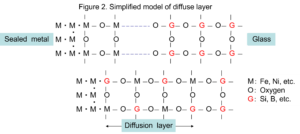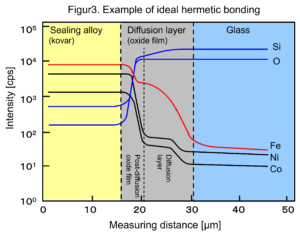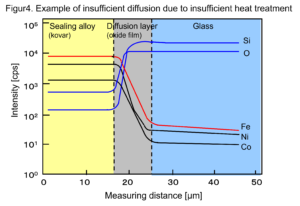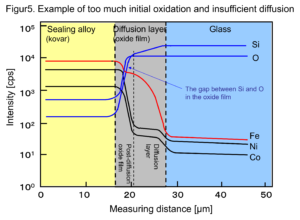COLUMN
Jun 04, 2024
Important conditions for hermetic bonding of glass and metal (part 3)
3. Diffusion layer formation of metal oxides in glass
Diffuse layer formation
When glass and metal are joined, the glass is softened by heating to bond it to the metal. At this time, iron oxides diffuse into the glass in the bonding area, forming a chemical bond that results in a highly airtight bond. The degree of diffusion (spread and depth) depends on the viscous flow of the glass and is also influenced by the heating temperature, heating time and heating method. The diffusion depth of the glass should generally be around 15 µm, as insufficient diffusion leads to leaks and excessive diffusion leads to reduced joint strength, so the formation of an oxide film before joining and the diffusion layer during joining are the most important parts of a glass-to-metal hermetic bond.

Examples of diffusion
So what are the ideal diffusion conditions? Let’s look at some examples of ideal and not-so-ideal joints with the Kovar joint example.
(1) Example of ideal hermetic bonding
In an ideal bonding, the iron oxide diffuses to the glass side, forming two layers: a post-diffusion oxide film and a diffusion layer. Furthermore, there is no displacement of oxygen and silicon in the post-diffusion oxide film. To achieve this state. It is necessary to form the oxide film before bonding and to set the heating conditions appropriately during bonding, which is where the know-how comes in.

(2) Example of insufficient diffusion due to insufficient heat treatment
Due to insufficient heat treatment, the iron oxide film is not diffused and a diffusion layer is not sufficiently formed. When this occurs, the chemical bond is not sufficiently formed, resulting in a weak joint strength and a greater possibility that the airtightness cannot be maintained.

(3) Example of too much initial oxidation and insufficient diffusion
If there is too much oxide film formed before bonding, the gap between Si and O in the oxide film after diffusion widens and needle-like crystals precipitate at the bonding interface. If this becomes too much, cracks occur and airtightness cannot be maintained.

Products hermetically bonded between glass and metal must not only be hermetically sealed, but must also be highly reliable, with no breakage or fracture during use. To ensure high reliability, it is important to fully understand the diffusion mechanism of the metal oxide film into the glass, so at Yamamura Photonics we have established the optimum control methods for pre-oxide film formation and heating power conditions. Yamamura Photonics vacuum vessels are still airtight after 30 years and have earned the trust of customers for their high quality. Although the Kovar case study is presented here, we also have extensive hermetic sealing know-how for materials other than iron and nickel alloys, such as silicon, germanium, tungsten and 426 alloys, so please feel free to contact us for more information.


